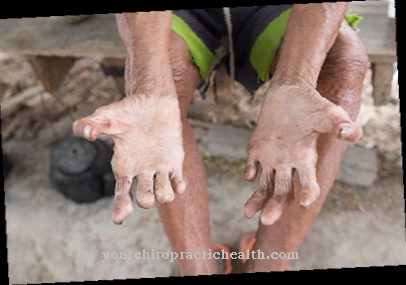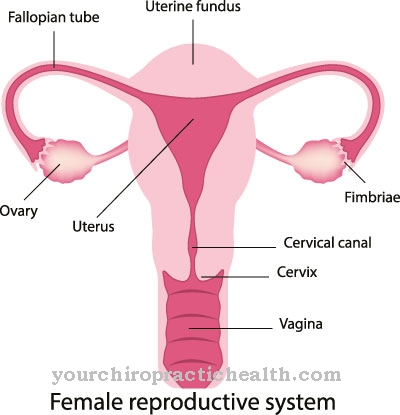Under PMS (premenstrual syndrome) various complaints that can be traced back to the female menstrual cycle and occur around 4 to 14 days before the onset of menstrual bleeding are summarized. Around 75 percent of sexually mature women are affected by PMS, with PMS severely impairing everyday life in around 5 percent of women.
What is PMS
.jpg)
© mspoint - stock.adobe.com
As PMS (premenstrual syndrome) is a series of different physical and / or psychological complaints that occur every month in a certain period of time, in the second half of the menstrual cycle, and usually subside when the menstrual period begins.
While mild forms of PMS are not recognized as a disease, severe forms of PMS, especially premenstrual dysphoria, are considered a mental illness that can have a significant negative impact on the everyday life of the women concerned.
PMS manifests itself symptomatically on the basis of varying, complex complaints, which cover a broad spectrum from headache and / or abdominal pain, hot flashes and water retention to severe psychological impairments such as mood swings, anxiety and depression.
Stress factors, an unbalanced diet with excessive consumption of nicotine, alcohol and caffeine as well as a lack of exercise can exacerbate the symptoms of PMS.
causes
The one PMS The underlying causes have not yet been conclusively clarified, which in part can also be attributed to the fact that in most cases the women concerned have a combination of causes.
On the one hand, hormonal imbalances are suspected, such as a disturbed presence of progesterone and estrogen, which could result from hormonal fluctuations during the menstrual cycle. On the other hand, PMS can be caused by an underactive thyroid or a disturbed melatonin level.
In addition, some hormonal contraceptives (e.g. birth control pills) can trigger PMS or worsen the symptoms associated with PMS. An unbalanced diet, lack of exercise, excessive consumption of alcohol and nicotine as well as psychosocial stress factors (problems in the professional and / or family environment) all contribute to an intensification of the symptoms typical of PMS.
Symptoms, ailments & signs
PMS can make the days before menstruation very painful in affected women. However, the specific complaints can be felt very differently. Many women experience PMS as an initially slightly tugging feeling in the abdomen that then becomes stronger. PMS can be felt four or more days before menstruation, but the symptoms often come immediately before menstruation.
In addition to symptoms that are also described as cramps in the abdomen, PMS can also affect the appearance of the skin. Many people suffer from pimples and oily skin in the days leading up to their period. The mind can also be affected by PMS. General malaise, lack of concentration or even depressive moods can be the result of PMS.
The changed interplay of hormones shortly before menstruation can lead to feeling irritable, tired and lacking in drive. Physical complaints such as pulling in the stomach can usually be alleviated with painkillers. A gynecologist should always be consulted if the symptoms are extremely severe. Before prescribing any special preparations, he or she must clarify whether another gynecological disease is causing the severe pain.
Diagnosis & course
To diagnose a PMS the affected woman is asked about her specific complaints and when they occurred as part of an anamnesis. In addition, it is clarified whether the PMS could be due to an underactive thyroid, endometriosis, depression, the onset of menopause (menopause) or other possible causes.
The hormone level can also be checked to determine if there is a possible hormonal imbalance. In some cases, especially if there are several complaints, a diary should be kept in which the various complaints are recorded with their respective degrees of severity.
As a rule, PMS disappears with the onset of the climacteric. A premenstrual syndrome associated with severe symptoms that severely affects the everyday life of the affected woman should always be treated, also because severe, untreated PMS increases the risk of breast cancer.
Complications
PMS, the premenstrual syndrome, is a great burden for many women. However, seven percent of those affected can show such severe symptoms that even the entire social environment is severely affected. Then there is talk of a premenstrual dysphoric disorder. Premenstrual dysphoric disorder is a real mental illness that can occur as part of premenstrual syndrome.
Affected women become difficult to irritate and sometimes highly aggressive. Although they know it is wrong, these women often show behavior during this phase that they would strictly reject in normal times. So it can happen that you get physical, hit your child, get screaming fits or even throw objects.
The women affected by premenstrual dysphoric disorder suffer a loss of control during this time. That is why they do not benefit from the insight that their behavior is wrong. The greatest risk for these women is that they can destroy their social environment with their kind. This can lead to a divorce or even the loss of the children.
The professional perspective is also often impaired due to illness. In the long term, this can result in social isolation, which in addition to the premenstrual symptoms often leads to other chronic mental illnesses such as depression.
When should you go to the doctor?
Premenstrual syndrome is not a disease in the strict sense and does not require treatment. In the case of mild to moderate symptoms, it is therefore not absolutely necessary to consult a doctor. In the course of the annual gynecological check-up, those affected should nevertheless describe the symptoms.
However, action is required if severe psychological and physical symptoms occur repeatedly in nine out of twelve cycles. In these cases it is advisable to consult a doctor, since the symptoms can rarely be caused by serious illnesses. The first point of contact is either the family doctor or the gynecologist.
Which doctor should be consulted depends on the symptoms present. If you have psychological problems, it may also be advisable to see an endocrinologist, psychiatrist or psychologist. If the symptoms are predominantly physical, those affected should consult a gynecologist or alternative practitioner. In general, many general practitioners and specialists are not properly trained in relation to premenstrual syndrome. In many cases, it can therefore be advisable to see more than one doctor. Conventional medical therapy approaches are not effective for some women. In these cases it is advisable to consider alternative approaches as well.
Treatment & Therapy
The therapy depends on you PMS to a large extent on the underlying complaints as well as the level of suffering felt individually by each affected woman. A mild PMS does not have to require therapy if the symptoms associated with it only slightly impair the everyday life of those affected.
To treat mild PMS, in many cases it is sufficient to learn relaxation techniques such as autogenic training or progressive muscle relaxation to avoid or minimize the effects of stress factors. Hormonal contraceptives with progestins are also used to treat PMS. Anti-inflammatory drugs (anti-inflammatory drugs) are used against pain and a low-salt and easily digestible diet can help against water retention, if you do not use alcohol, nicotine, caffeine and / or diuretics.
In some cases, herbal remedies (wolfsbane, monk's pepper) and / or an additional increase in magnesium and vitamin B intake can provide relief. In individual cases, psychological support for the affected woman through behavioral or psychotherapy may be indicated, while antidepressants (such as amitriptyline) are used therapeutically in the presence of depression.
Outlook & forecast
Premenstrual syndrome depends on many contributing factors. Girls and young women who suffer from PMS may notice a significant improvement in symptoms towards the end of puberty and the entry into adulthood. At best, as adult women, they experience no or only mild symptoms. If an adult patient continues to suffer from PMS, then she will most likely experience the symptoms until the menopause.
There are factors that make the symptoms worse or that can also alleviate them. Consumption of nicotine and caffeine can have an intensifying effect, while combinations of certain fatty acids in the diet can alleviate the symptoms. A change in diet can therefore have a positive effect on well-being. A sedentary lifestyle can also be a reason why premenstrual symptoms are more severe than necessary. Sport and fitness can have a preventative effect.
Certain diseases such as thyroid disorders, fungal infections or sleep problems also increase the symptoms of PMS. Although the premenstrual syndrome cannot be cured, the affected woman can still try to alleviate the symptoms without taking medication. If symptoms are severe, pain relievers may be taken to relieve the symptoms enough to cope with normal everyday life so that the social consequences of PMS are not unnecessarily severe.
prevention
One PMS cannot be specifically prevented due to the fact that the causes have not been finally clarified. However, the extent of the respective symptoms can possibly be positively influenced by a balanced diet, avoiding excessive consumption of nicotine, alcohol and caffeine, physical activity and relaxation techniques to reduce stress. In addition, the risk of disease is increased in the case of obesity (overweight). The risk of developing PMS can be minimized by reducing weight.
Aftercare
It is not entirely correct to speak of follow-up care in the area of PMS, since it is a symptom that usually recurs monthly. If the symptoms that the woman is experiencing are particularly severe, monthly follow-up care can be provided to support physical and psychological regeneration.
This can be done through warm baths, gentle endurance training or massages and depends on the individual's well-being and taste. A sufficient amount of water to drink, a healthy diet and enough sleep can also be integrated into the aftercare after the often very uncomfortable days of the premenstrual syndrome.
Often times, women can treat PMS themselves with herbal remedies such as monk's pepper. If this succeeds, it is part of the aftercare to reliably adhere to the dosage. Regular visits to the gynecologist are also included in the follow-up care to ensure that, for example, no other disease is hidden behind the breast tenderness believed to be PMS.
Learning relaxation techniques is also a means of making follow-up care meaningful. PMR (progressive muscle relaxation), AT (autogenic training), fantasy journeys and yoga are just a few examples of many. Aftercare also includes the woman observing what is particularly good for her during the PMS. These measures can be started early by keeping a cycle calendar.
You can do that yourself
PMS (premenstrual syndrome) is a common and regularly occurring phenomenon. For women affected there are a whole range of possibilities to alleviate the unpleasant symptoms often noticeably through self-help in everyday life. This is often particularly reliable because the occurrence of PMS is easy to predict because it depends on the woman's monthly cycle. In this context, self-help is possible for both physical and emotional complaints that PMS brings with it as a very individual symptom pattern.
In the physical area, the uncomfortable breast tenderness and skin blemishes are particularly important. Chasteberry supplements are often suitable for reducing feelings of tension in the chest. A bra that provides good support ensures that the pain that often occurs when moving is reduced. The blemishes can often be alleviated with mild antiseptic cleansing products.
In the mental area, the range of possible complaints such as fears or depressive moods, but also tiredness, can be alleviated with physical activity. Exercise in the fresh air, such as walking or swimming, is particularly recommended. If you want to take it a little easier, you will find balance in yoga or progressive muscle relaxation. It often also helps to terminate stressful private or professional obligations so that they do not fall into the PMS phase and do not put additional stress on those affected.

.jpg)


.jpg)



















.jpg)



